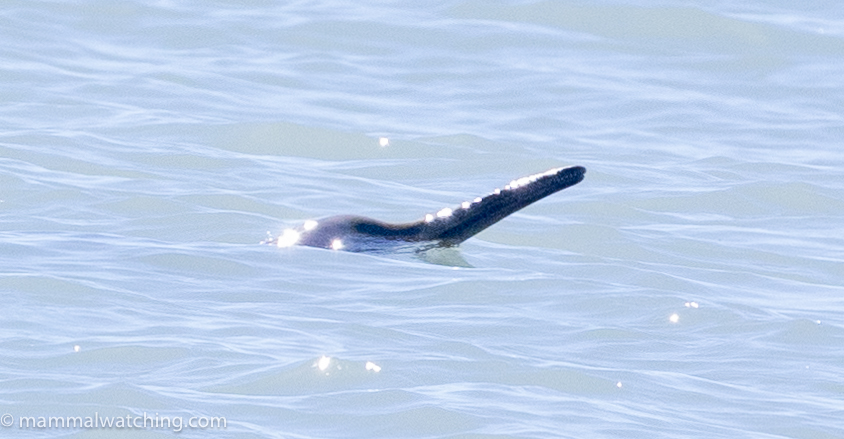
Buenos Aires Province, Argentina. December 2023
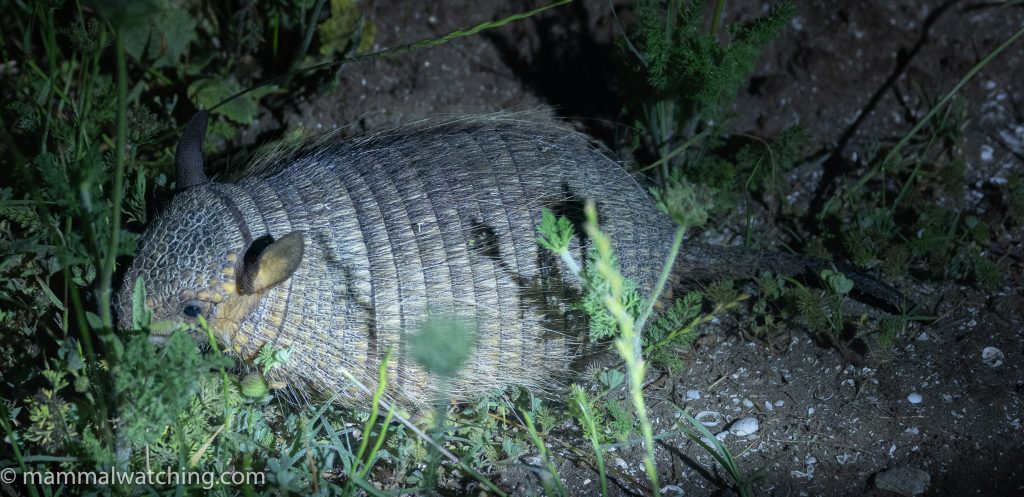
Screaming Hairy Armadillo (Chaetophractus vellerosus)
I spent a week in Argentina in December 2023, travelling through Buenos Aries Province for what was a wonderful week in search of Franciscana dolphins, Screaming Hairy and Brazilian Lesser Long-nosed Armadillos (formerly Southern Long-nosed Armadillo but now lumped) and Big Lutrine Opposums, along with whatever else we could find.
I travelled with Sion, one of my oldest friends who while not a mammalwatcher does seem to enjoy these trips. We were guided by Marcelo Gavensky: I cannot say enough good things about Marcelo, but I will try to say some of those good things at the end of this report. But, by way of an introduction, Marcelo is a well known bird guide and runs Birds Argentina. But don’t let that put you off! I started talking to Marcelo in 2022 after he guided a Royle Safaris’ Argentina trip. Martin Royle was impressed both with Marcelo and his growing interest in mammals and put is in touch. Marcelo and I started talking about his Argentinian mammal list and we bonded very quickly. I needed to go back to Argentina and go with Marcelo.
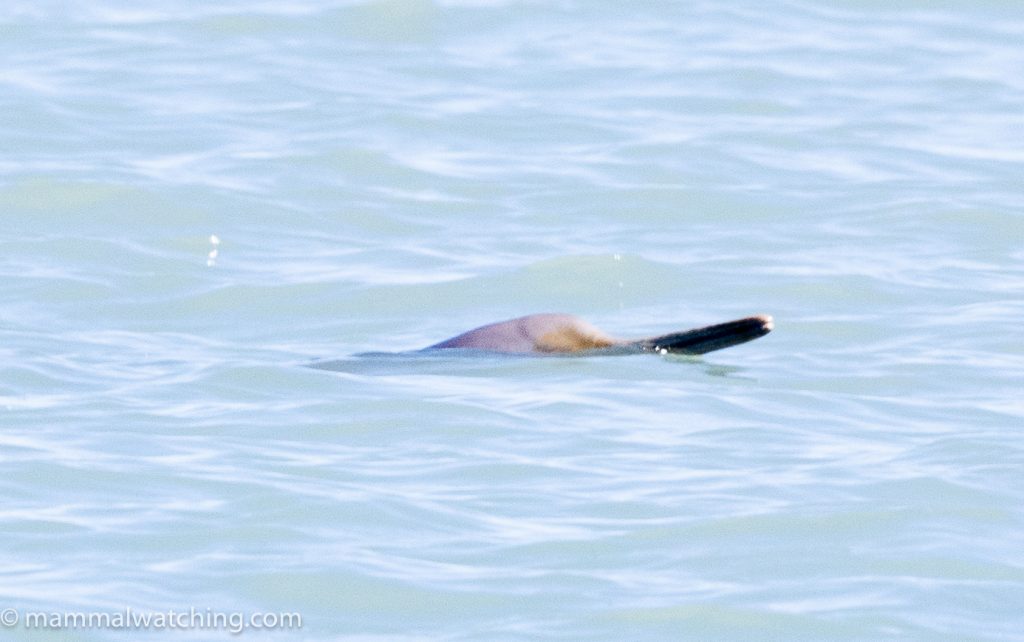
Franciscana (Pontoporia blainvillei)
My main target for the trip was the Franciscana, or La Plata River Dolphin, a monotypic species in a family of their own. There is probably a taxonomical way to say this in one word … mono-something … but I don’t know what it is.
This trip was fairly relaxed even if that term is, I realise, relative to other tips I have take rather the other people’s holidays. But Marcelo and I baked in plenty of time in one small part of the country because of the unpredictability of the weather and its impact on Franciscana finding. Marcelo thought the dolphins ought to be quite easy to see if we could get a day with flat seas, but those conditions were far from guaranteed so we needed time in the right habitat. This suited me fine because I knew very well the delights of Argentinian beef and wine and wanted also to make sure we had time to enjoy this too. Please don’t be concerned – we never went hungry. Though by the end of the week even I was ready for a salad, or at least a vegetable that wasn’t french fried.
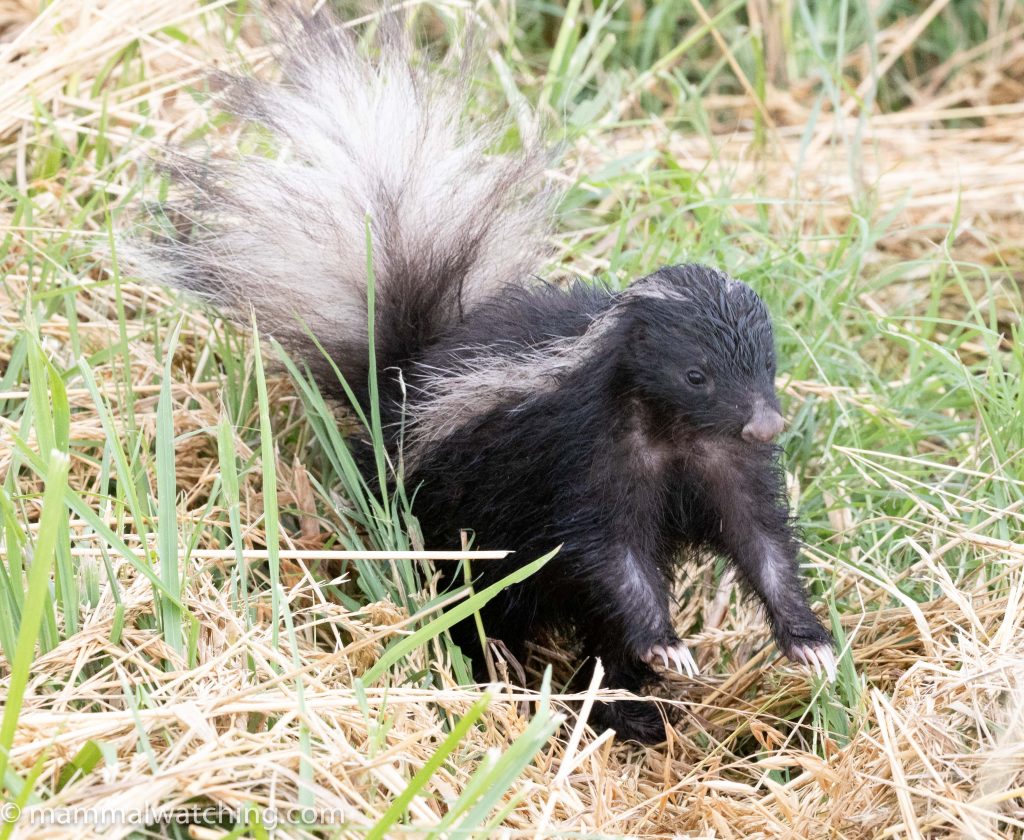
Molina’s Hog-nosed Skunk (Conepatus chinga)
Sion and I had very different trips to Buenos Aires. I took a short and punctual flight from Santiago on a plane that was half full of the British pop group Blur. Sion arrived three hours late after a long flight from the UK via Brazil. His flight was delayed because the passenger sitting across the aisle from him died somewhere between London and Rio (and Sion had had to help move his corpse to the galley). You might imagine that karma would ensure at least that his luggage arrived safely. Apparently karma doesn’t work like that..
But a delicious steak at La Brigada (this is a restaurant where the waiter slices the steak open with a spoon) was more than enough to wash away the trauma of the previous 24 hours. But maybe I I should just get over having to sit behind Blur and stop complaining. Sion had handled it all much better than I would have.
Our itinerary had us leaving Buenos Aries early Sunday morning and driving a few hours south to stay near Pipinas. From there we planned to spend Monday through Thursday nights heading along the coast in prime Franciscana habitat before returning to BA on Friday or Saturday night.
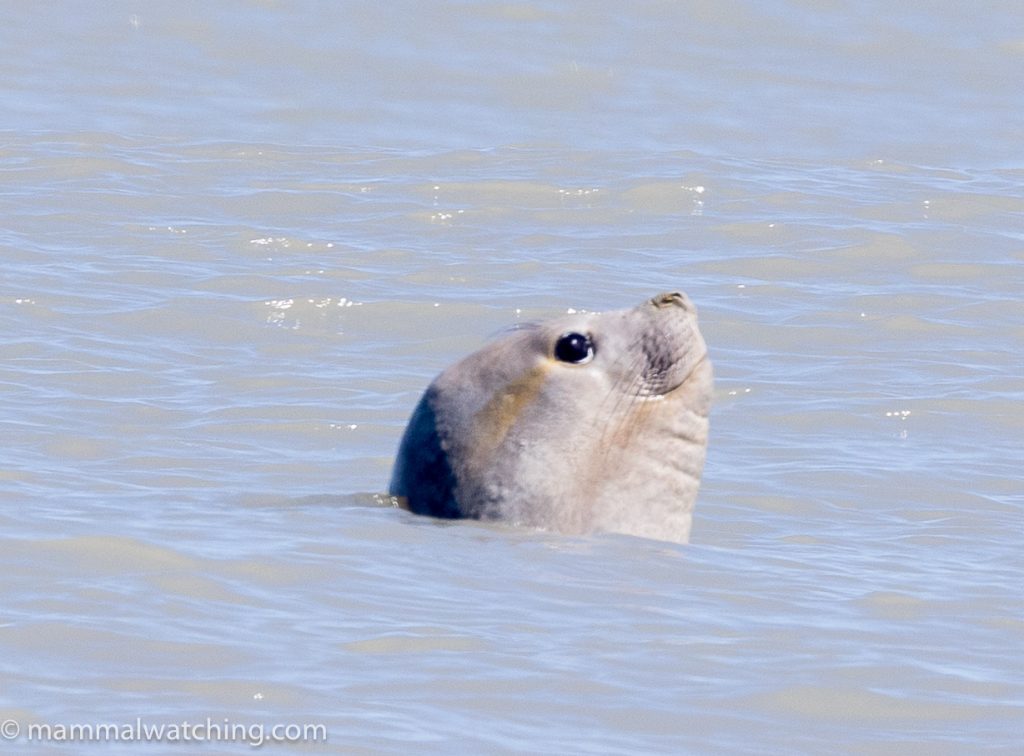
Southern Elephant Seal (Mirounga leonina)
A few notes on Argentina
In December 2023 the Argentinian economy was a mess. Inflation was over 100%, which meant restaurants did not include prices on printed menus because they would be out of date within a few days. Until very recently the Argentinian peso was worth very different amounts against foreign currency depending on whether you used the official exchange rate or the unofficial (black market) rate. The latter would give you twice the pesos for your dollar. But just before we got there the government recognized the futility of this and, from what I understood, introduced a different rate for tourists using credit cards: a rate that was pretty much set at the old black market rate. And so the entire country was extremely affordable. It was hard to spend more than $40 on dinner at even the greatest restaurants in Bueno Aries and the first place we stayed outside of the city – El Manatial a lovely cattle station – charged $20 a person for accommodation including breakfast and a steak dinner.
If you are going to Argentina soon then be careful about booking hotels on international travel sites. On several occasions we almost booked hotels that has prices advertised on sites in pesos but which the travel site then wanted to charge for in USD using the ‘old’ exchange rate. This made them twice as expensive as they ought to be. This might be because the sites had not adjusted to the new – and unusual – variable exchange rate system. Or maybe they were just price gouging…. but it is safer to pay locally for hotels.
In early December the weather was mainly glorious (temperatures did not get above 25C though it can be much warmer) and the busy summer holiday season had not started.
I didn’t have a field guide other than the Lynx Eds Mammals of the Southern Cone. Marcelo also put me onto this excellent website which covers all of the mammals in detail.
Sunday November 26: Refugio El Manatial
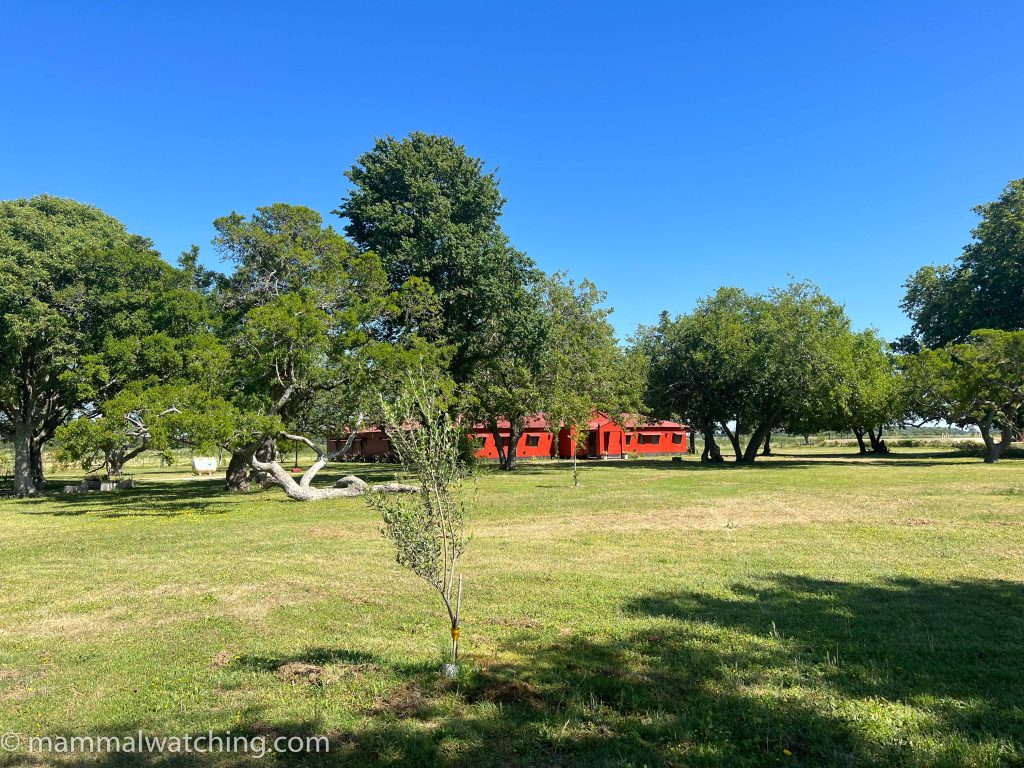
This lovely cattle station is about three hours’ drive from Buenos Aires city centre. We took our time, exploring dirt roads along the way in search of Screaming Hairy and Brazilian Lesser Long-nosed Armadillos, both of which can often be seen in the day time.
We stopped at a gas station close to the refugio and I found a few Brazilian (Mexican) Freetail Bats in cracks in the ceiling of the women’s toilets. Marcelo has seen Yellowish Myotis in the gent’s loos here before but we couldn’t spot any. Furtively walking into the women’s washrooms, with binoculars, a long lens and an air of excitement, might not have been the best move in hindsight.
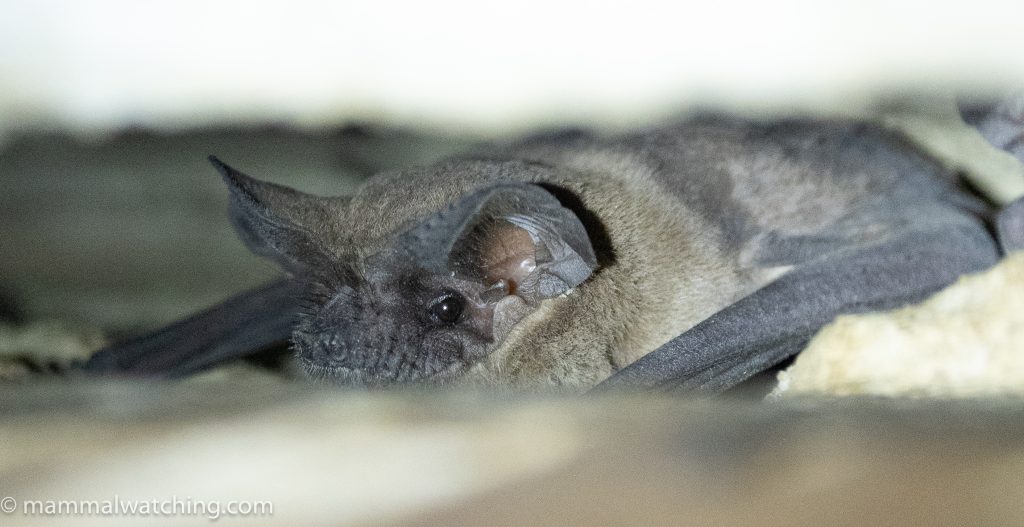
Brazilian Free-tailed Bat (Tadarida brasiliensis)
We spent the night at Refugio El Manatial – a working cattle ranch – which was a lovely place to stay, and, as I mentioned earlier, ridiculously cheap. Sion’s luggage was delivered a few minutes after we arrived and we spent the afternoon looking for armadillos and Talas Tuco-tucos on the ranch. Judging by the large quantities of birds, bugs and animals we saw running around the farm must be doing something ecologically right, which I suspect includes not using pesticides.
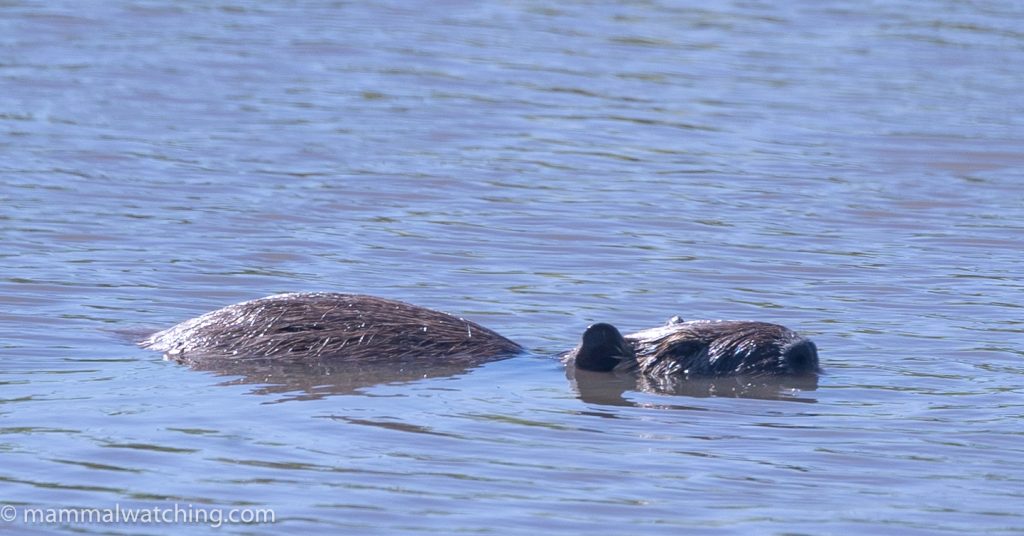
Coypu (Myocastor coypus)
A family of Coypus (native here) were living in the ponds behind the house. We could not find any armadillos in the daylight, nor spot any tuco-tucos but their tunnels were everywhere and we could hear them calling from underground: I hadn’t realised that ‘tuco-tuco’ comes from the loud calls they make. Marcelo said that tuco-tucos were usually fairly easy to see, or easier than many gophers seem to be: with some patience you can often find them at the entrance of their tunnels particularly in the early mornings or late afternoons.
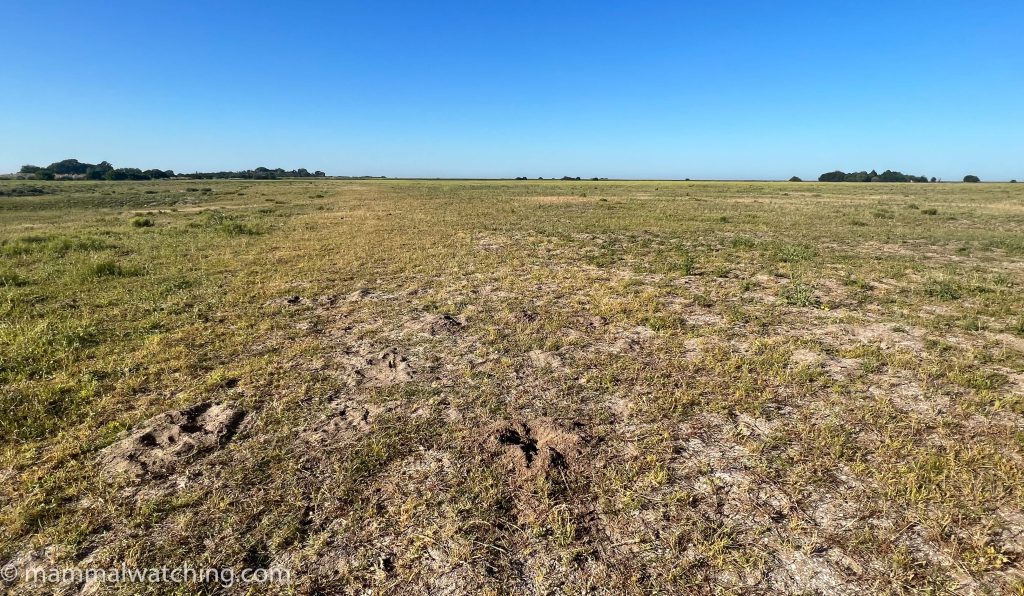
Talas Tuck-tuco habitat
Sion spotted what must have been a melanistic Geoffroy’s Cat and we saw some feral Chital Deer and European Hares along with a Pampas Fox or two. Just before sunset we took a drive along roads outside the ranch: Marcelo spotted a Brazilian Lesser Long-nosed Armadillo which I missed although he assured me we would see more. Along the roadsides we saw our first Brazilian Guinea Pigs and Plains Viscachas of the trip.
After a three course dinner – almost exclusively involving red meat – we drove back into the station to look for armadillos with our thermal scopes. After several Large Hairy Armadillo false alarms we saw what appeared to be a smaller animal that was considerate enough to stop for photos at my feet: the wonderfully named Screaming Hairy Armadillo, described by their habit of screaming if handled.
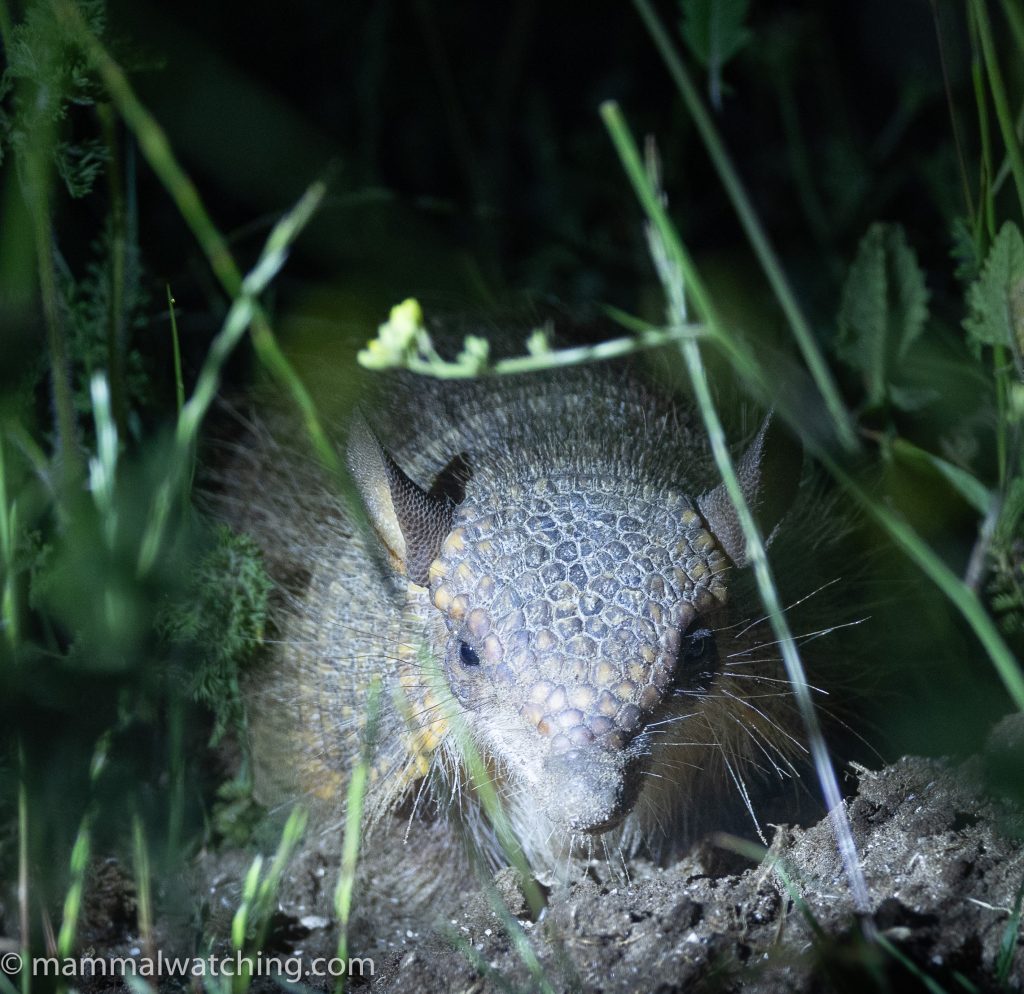
Screaming Hairy Armadillo (Chaetophractus vellerosus)
We also saw a Molina’s Hog-nosed Skunk and a White-eared Opossum. We were off to a pretty good start.
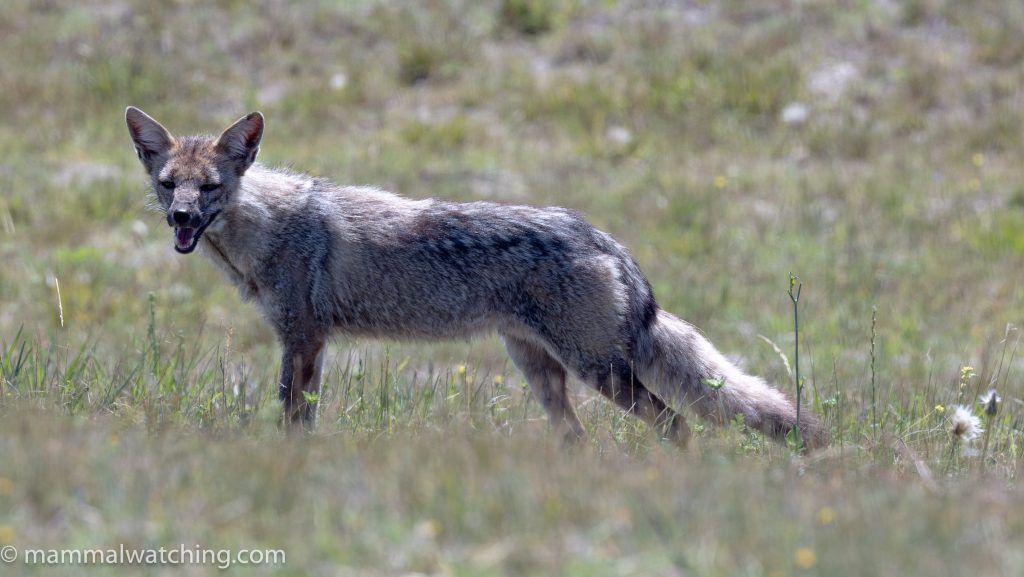
Pampas Fox (Lycalopex gymnocercus)
The next morning we tried – and failed – again to find active tuco-tucos. I suspect this Pampas Fox was also looking for them. I also got my first look at a Brazilian Lesser Long-nosed Armadillo. And then we headed to General La Valle.
Monday November 27: General La Valle
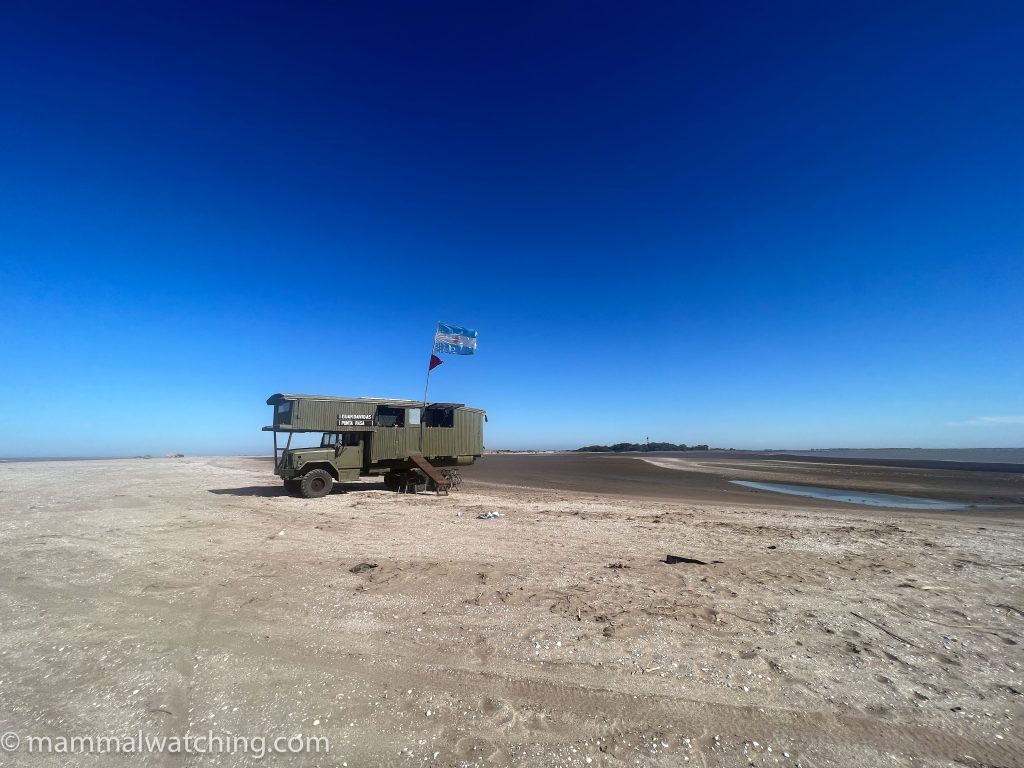
Punta Rasa: Franciscana central
After lunch and a siesta in General Lavalle we drove to Punta Rasa: a peninsula on the southern end of Samborombón Bay and at the mouth of the La Plata River estuary (100 miles almost south south west of Montevideo).
Punta Rasa is where cetacean expert Bob Pitman saw his Franciscanas: he saw them from the beach at low tide. Marcelo had seen them here too and so he arranged for us to take sea kayaks out with Limosa Kayak Expeditions. It was a fun two hours though harder work than I expected. It was windy and dolphin spotting – as well as paddling – was difficult so it is little surprise we didn’t see any. The kayak guys see the dolphins quite often though this was the first time they had been out especially to look for them.
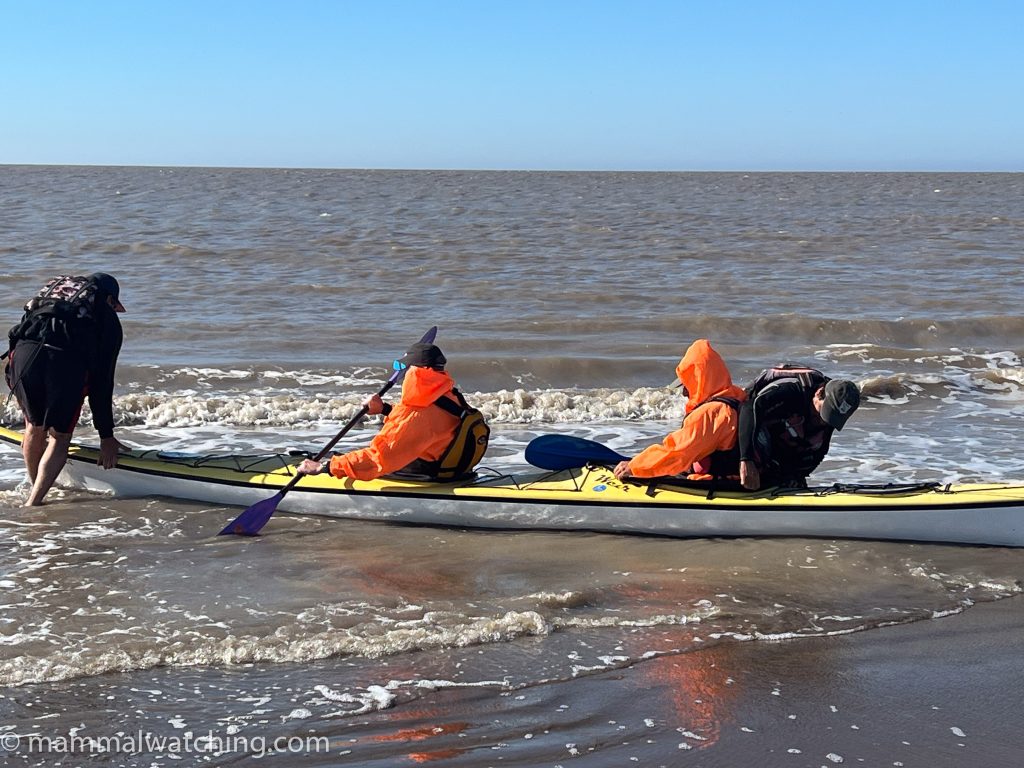
A pair of Southern Elephant Seals were hauled out on the point. A much rarer sighting here than Franciscanas.
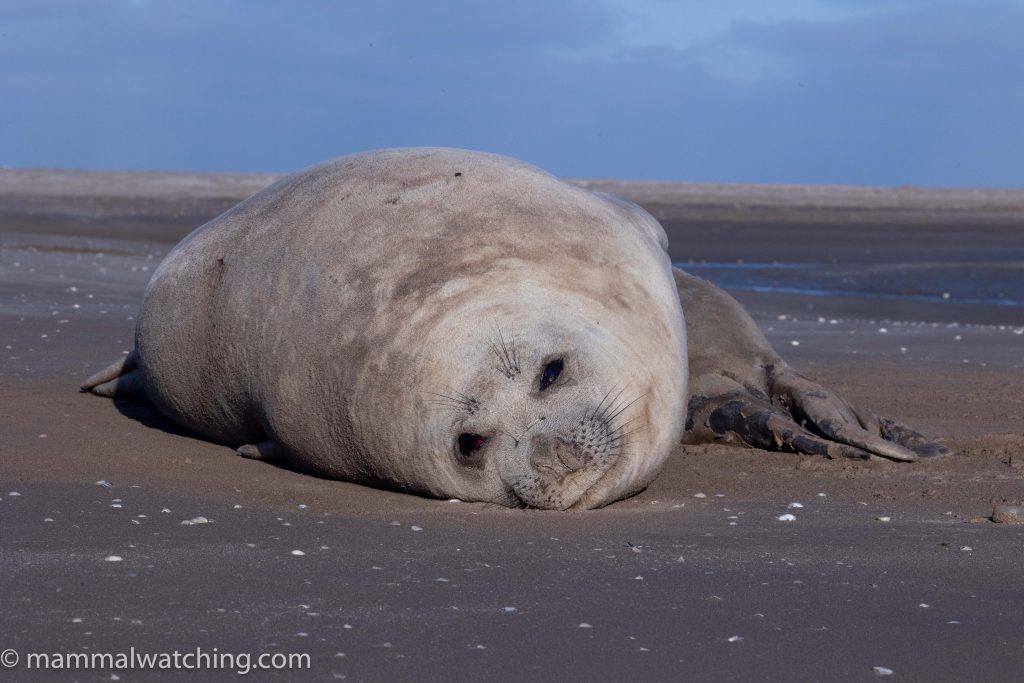
Southern Elephant Seal (Mirounga leonina)
In the evening we visited a nearby farm called El Palenque, a well known birding site. The road through the farm is, technically, open to the public. But it seems they are not used to visitors at night. And, ‘acting on information received’, the police had set up roadblocks to intercept us as we drove back to town. It did not take too much to persuade the cops we were not cattle rustling, even if they looked a bit sceptical that we were out there looking for armadillos and opossums.
Marcelo had seen Big Lutrine Opossum here once or twice in wetlands on the farm. But water levels were low and we were not lucky. We did see a Large Hairy Armadillo, Molina’s Hog-nosed Skunk, Pampas Foxes and the ubiquitous European Hares along with many mice that we found with our thermal scopes. We had decent looks at them but got no photos. They must have been Azara’s Grass Mice.
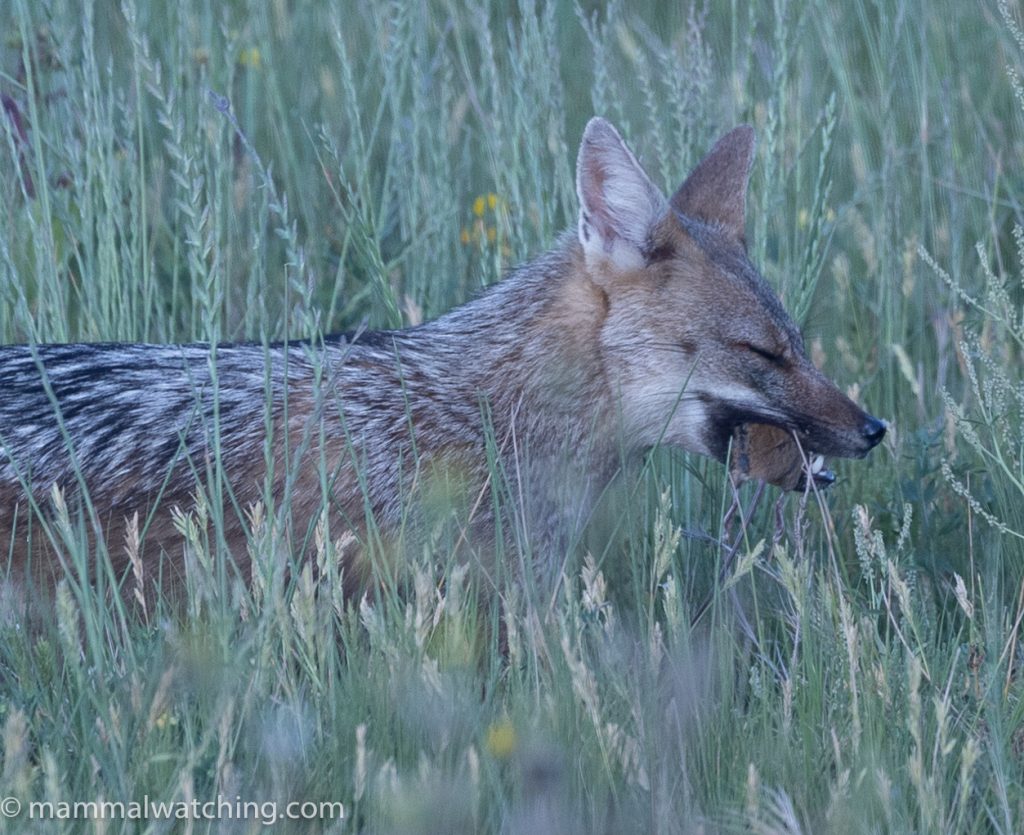
Pampas Fox (Lycalopex gymnocercus) munching on a Yellow Pygmy Rice Rat (Oligoryzomys flavescens)
We returned early the next morning and saw a fox eating a Yellow Pygmy Rice Rat. Sadly for me and, possibly more sadly for the rat, it was too dead to count.
Later than morning we visited a small private reserve near the town of General Lavalle and just outside Campos del Tuyu National Park. The area is home to some about 200 Pampas Deer, a rare species in Argentina and Marcelo arrange access through Soledad, a local ranger, who also accompanied us.
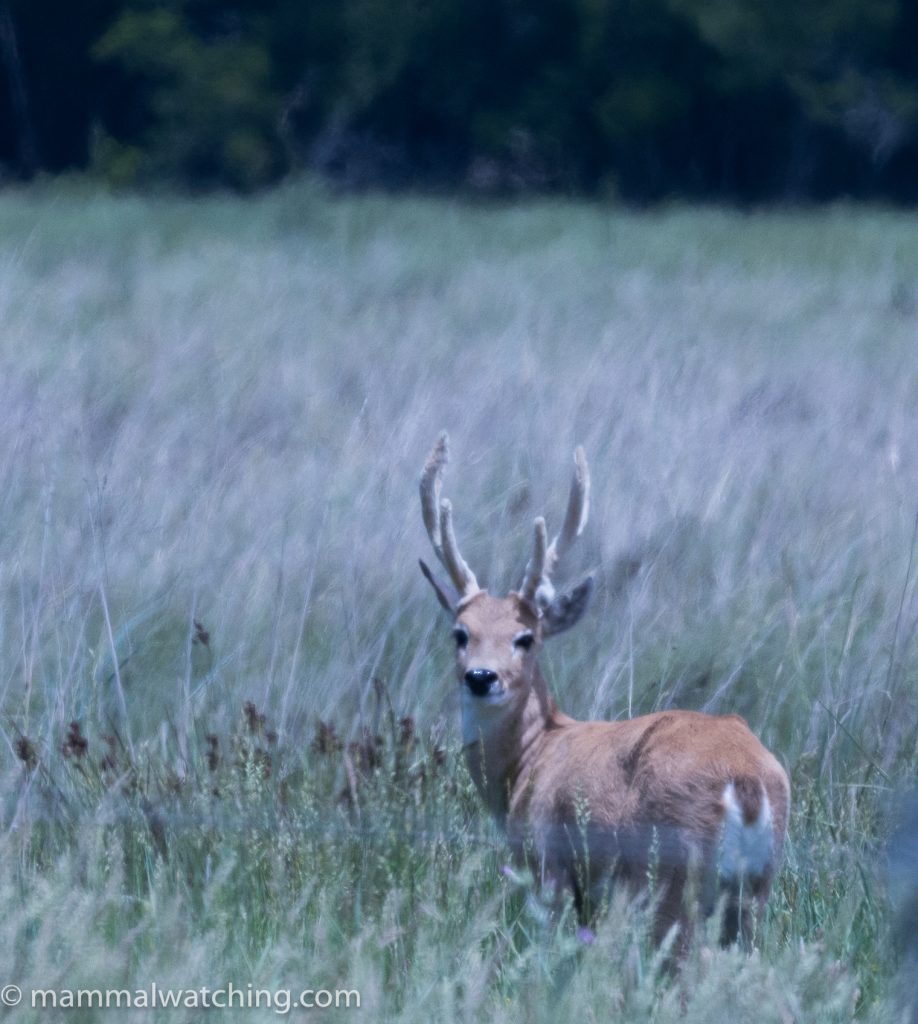
Pampas Deer (Ozotoceros bezoarticus)
Distant Pampas Deer were easy to find after which I turned my attention once more to the Talas Tuco-tucos. Evidence of their presence was everywhere but it took us 45 minutes of slowly walking around their colonies before Soledad spotted one at the edge of its burrow. It kindly stayed put for the next 15 minutes.
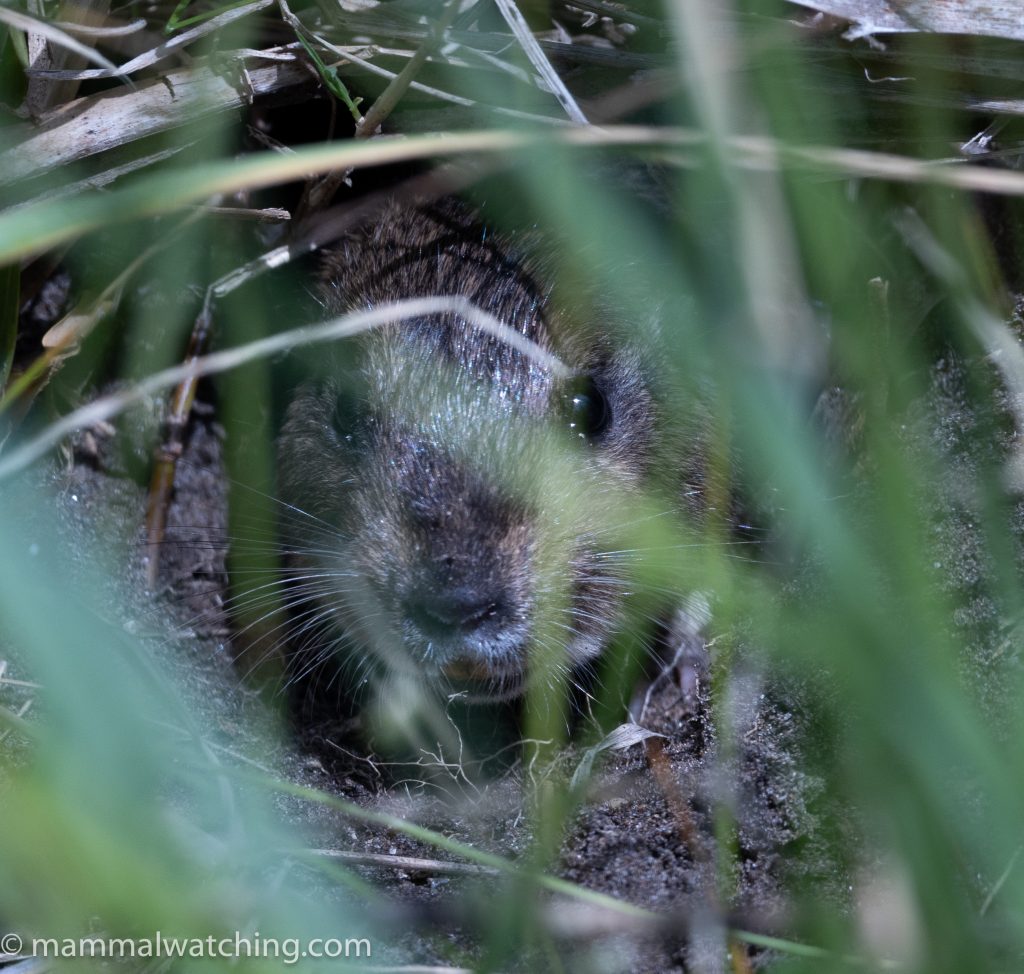
Talas Tuco-tuco (Ctenomys talarum)
And from there we headed further south towards Mar Chiquita.
Tuesday and Wednesday, November 28 & 29: Mar Chiquita
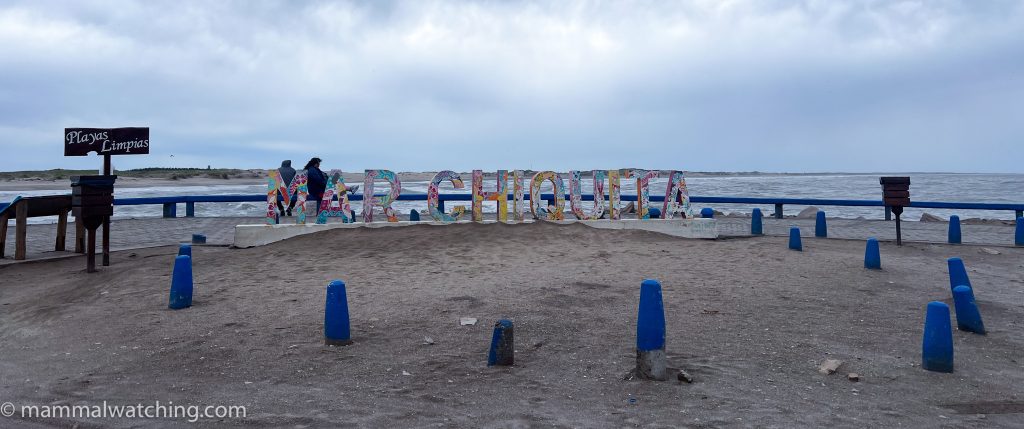
Our next destination was the small town of Mar Chiquita where we would spend two nights. On the drive down we stopped at Balneario Mar Azul for a few hours. Marcelo had arranged for a local to drive us along the beach for a couple of hours in his Hi Lux in the hope we might see a Franciscana at the edge of the surf. They are not uncommon here.
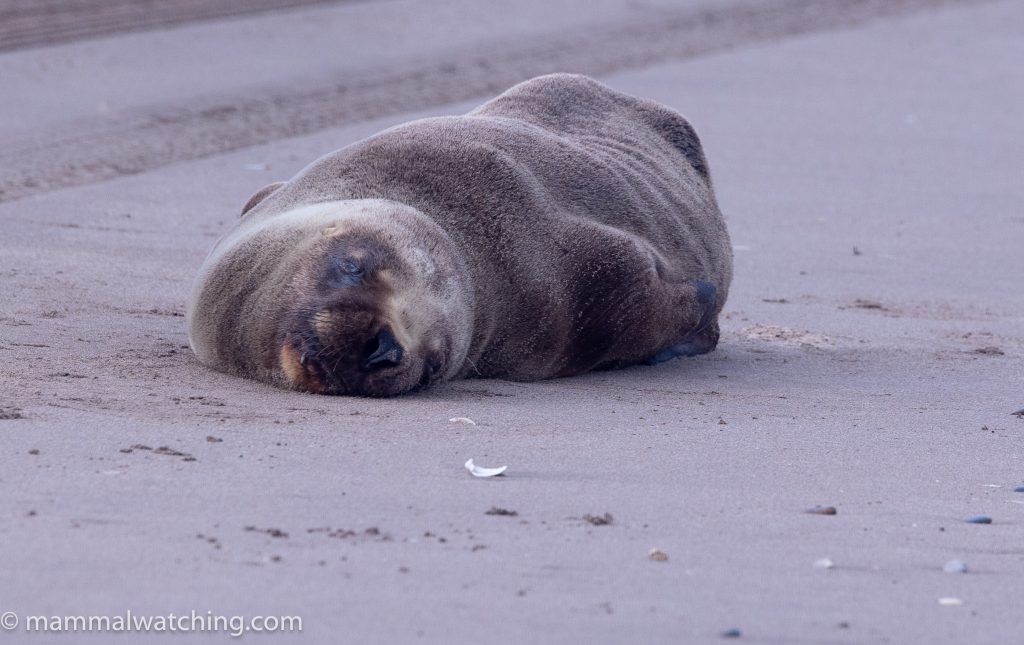
South American Sea Lion (Otaria flavescens)
The beach was long and desolate. But it was windy, the sea was rough and the drive – with the windows open – was very cold. No dolphins. Though we did see a South American Sealion on the beach and this juvenile – and sadly dead of course – Franciscana.
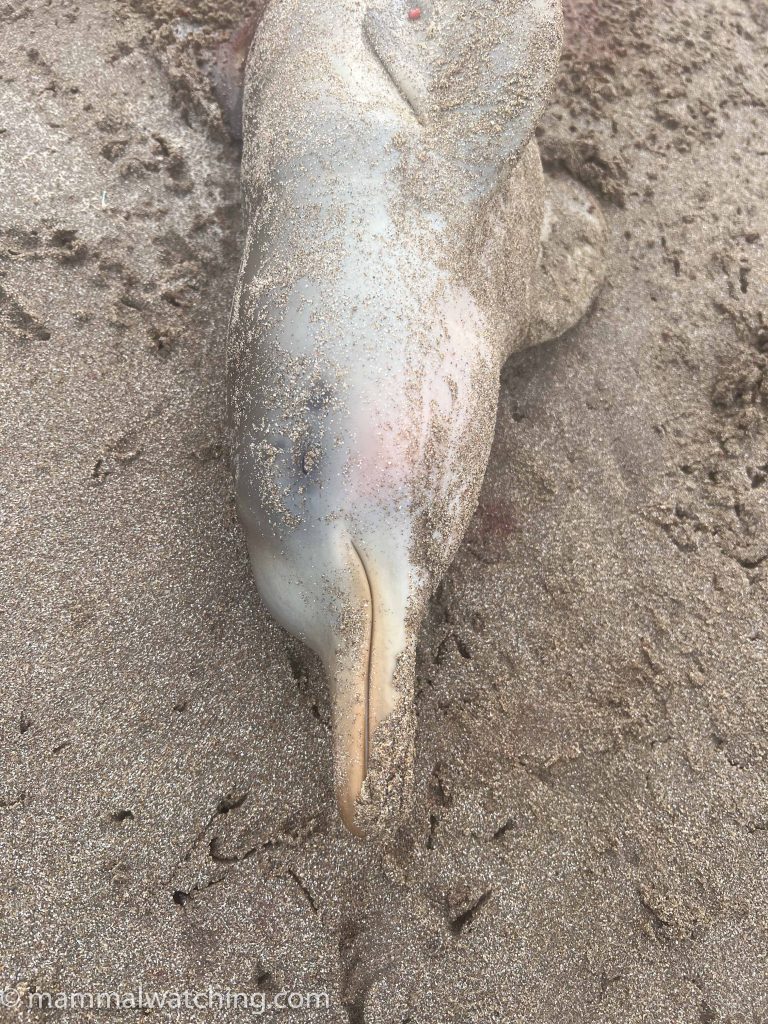
Franciscana (Pontoporia blainvillei), deceased.
We spent two nights in Mar Chiquita. Very little happens here outside of the summer season and our hotel opened especially for us. The sea was still fairly rough on our first morning but after 5 minutes of scanning from the beach I briefly saw a small dolphin no more than 100 metres offshore that must have been a Franciscana. It was impossible to follow between the waves.
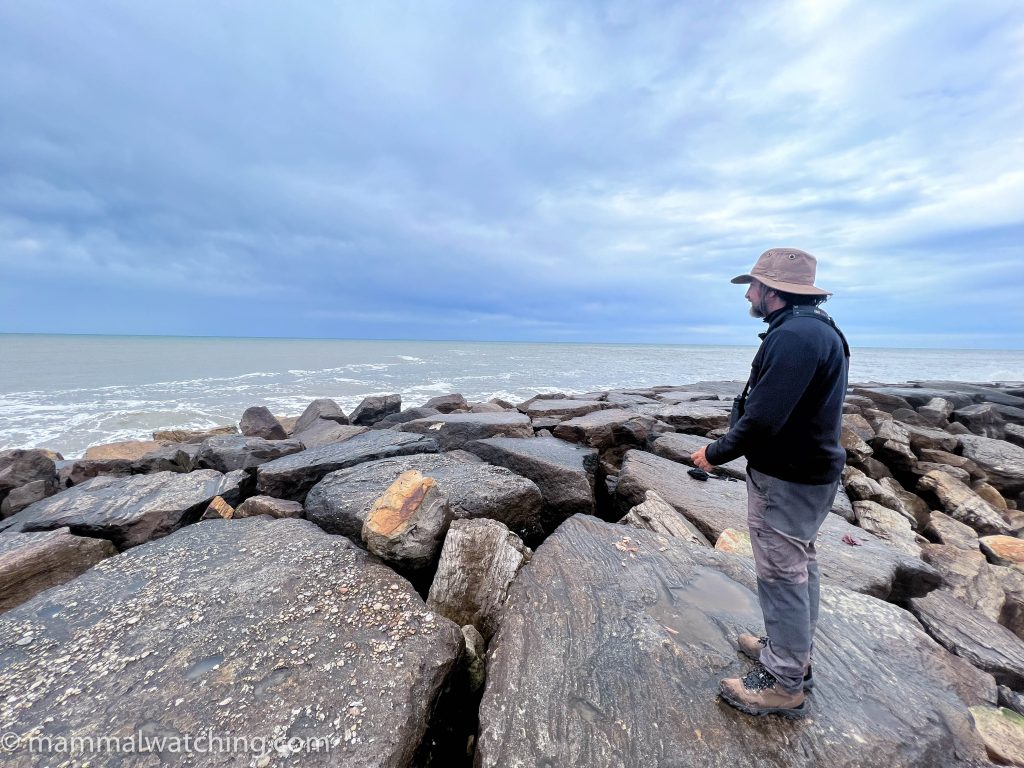
Marcelo watches for a Franciscana
By early afternoon the wind had dropped and we returned to another beach at Mar de Cobo a couple of miles to the south. And I very quickly saw one or more Franciscanas patrolling the sea just beyond the surf. I even got a photo.
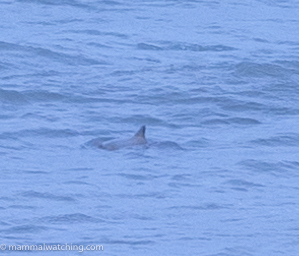
Franciscana (Pontoporia blainvillei)
A terrible photo admittedly… but we were getting closer!
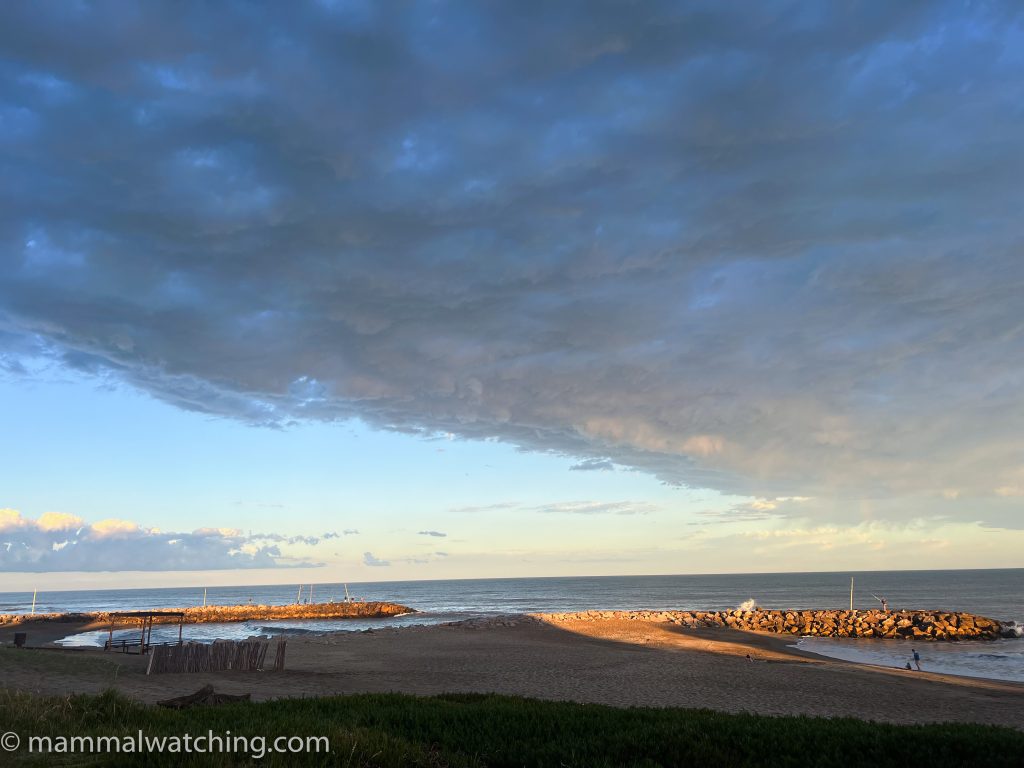
Mar de Cobo
Our next stop was a ranch on the edge of Laguna Nahuel Ruca. Marcelo knew the owner, Pedro, who is interested in wildlife and had hosted several research projects on the farm. He was happy for us to set a few sherman traps for rodents and showed us around his property. The habitat looked great but all the traps were empty the next morning. The only mammals was a White-eared Opossum in the mid-afternoon near the farm house.
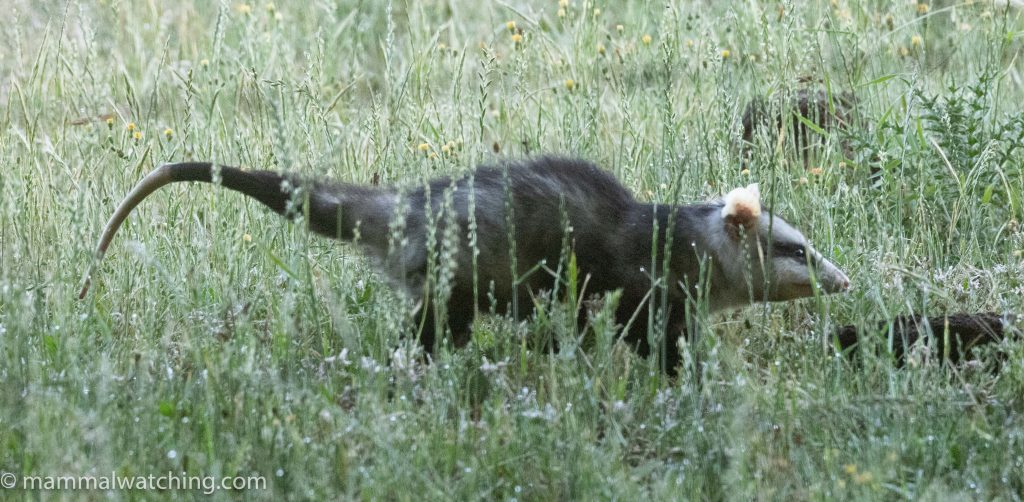
White-eared Opossum (Didelphis albiventris)
At dusk Marcelo took us to a quiet road that led to some kind of military base. Brazilian Guinea Pigs were abundant and he has seen Lesser Grisons here.
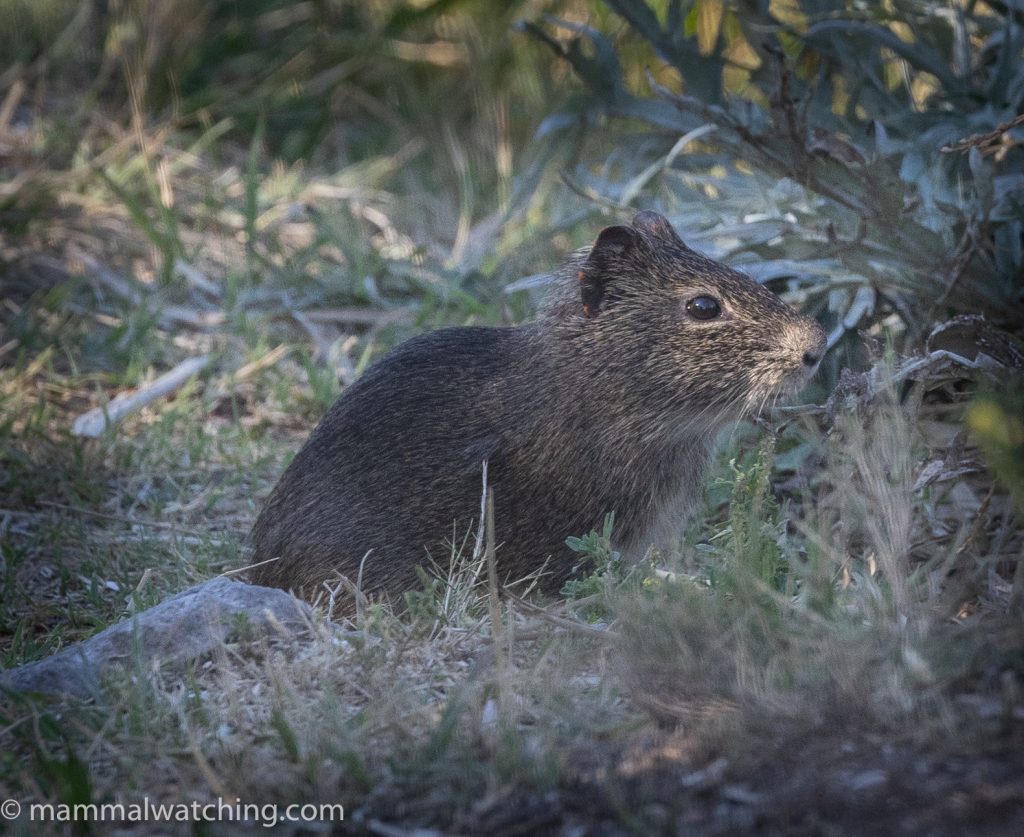
Brazilian Guinea Pig (Cavia aperea)
We must have seen 15 or more guinea pigs darting across the short stretch of road leading to the locked gate. But no grisons.
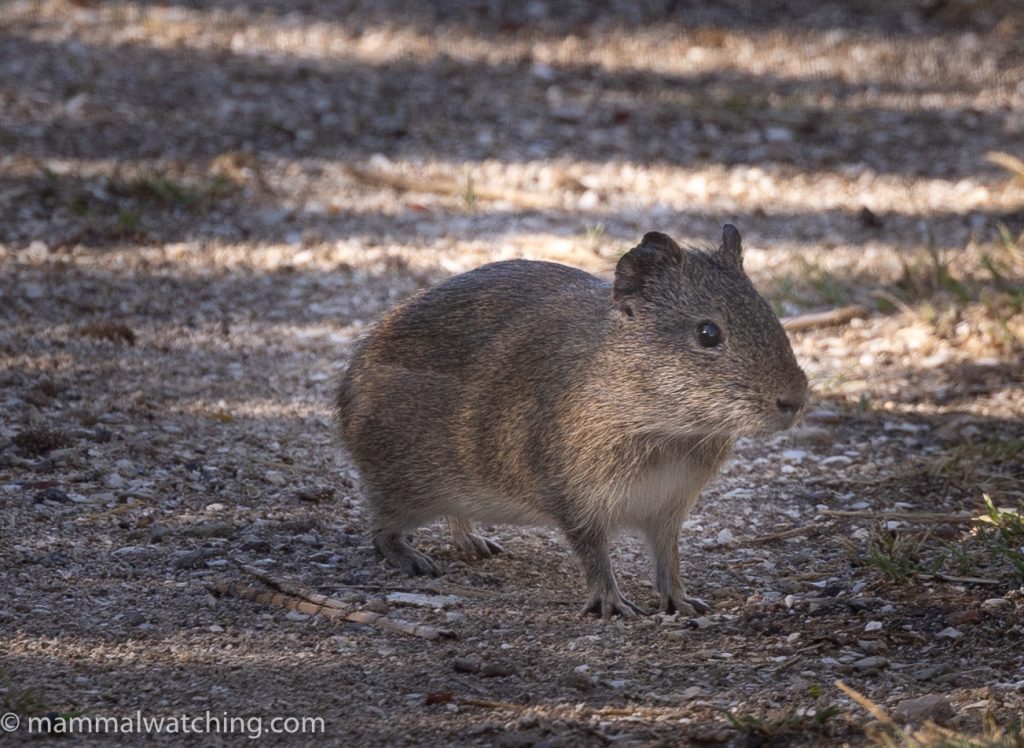
Brazilian Guinea Pig (Cavia aperea)
On Thursday morning we met up with a local fisherman at the Mar Chiquita Harbour to go Franciscana watching. Marcelo had put a good bit of research into finding the ‘right’ guide and, so far as we know, we are the first ecotourists to have chartered a boat to go looking for Franciscanas.
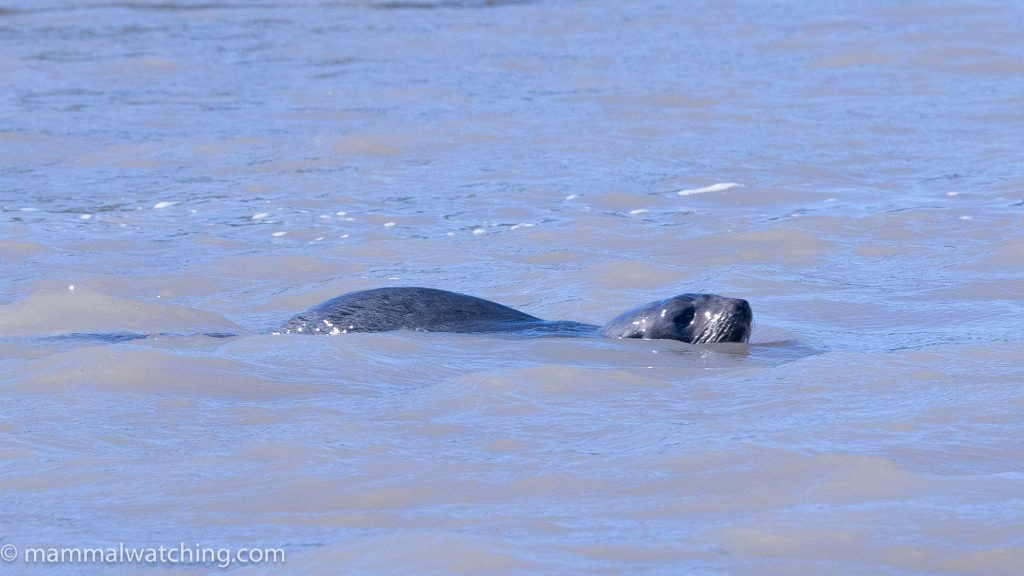
South American Fur Seal (Arctocephalus australis)
Before we had left the harbor we were greeted by a South American Fur Seal, a lifer for me and a species we were not expecting until tomorrow.
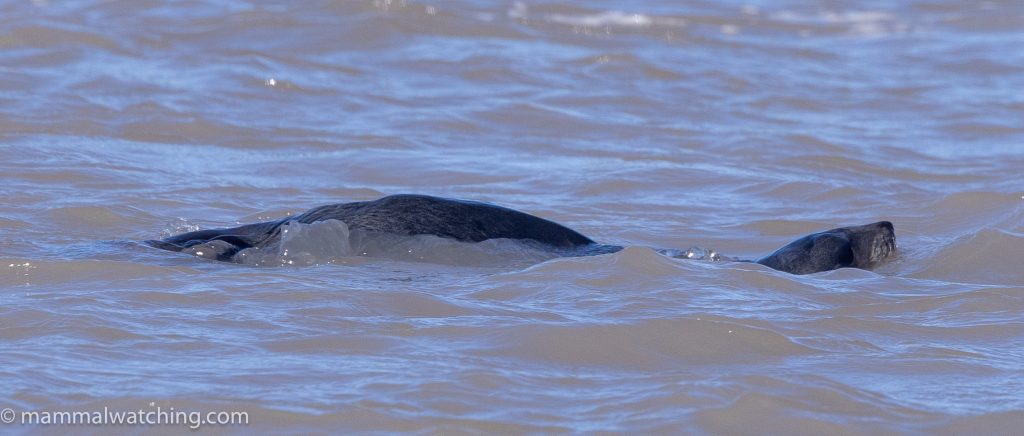
South American Fur Seal (Arctocephalus australis)
The conditions were perfect for dolphin spotting. We motored south along the shoreline and after about 45 minutes came across our first small pod of Franciscana, patrolling the sea beyond the surf break.
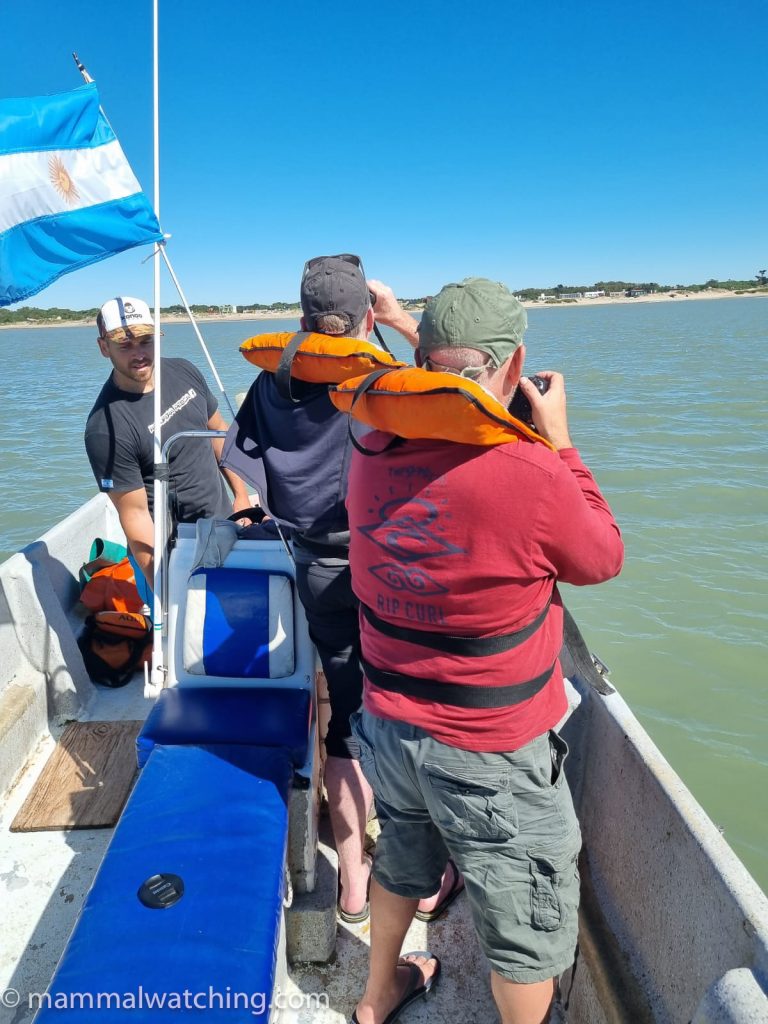
We spent about an hour with the dolphins. It is hard to estimate how many different animals we encountered but Marcelo though somewhere between 15 and 20. We had at least seven in the pod we spent most time with.
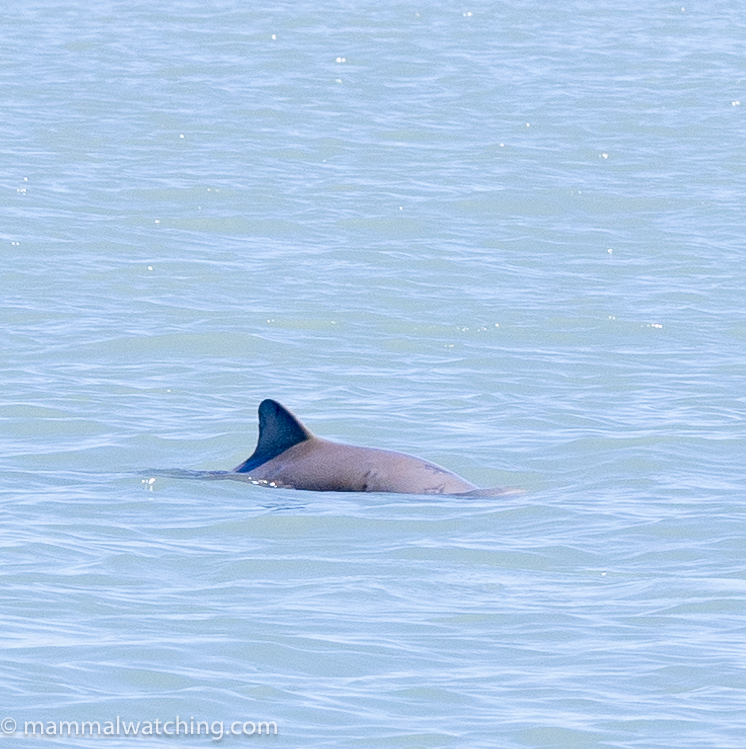
Franciscana (Pontoporia blainvillei)
The animals were hard to photograph. They were often close but surfaced briefly and unexpectedly so photography was more luck then judgement. Marcelo managed to capture some impressive video here.

Franciscana (Pontoporia blainvillei)
As you can see from the image below the animals were close to shore.
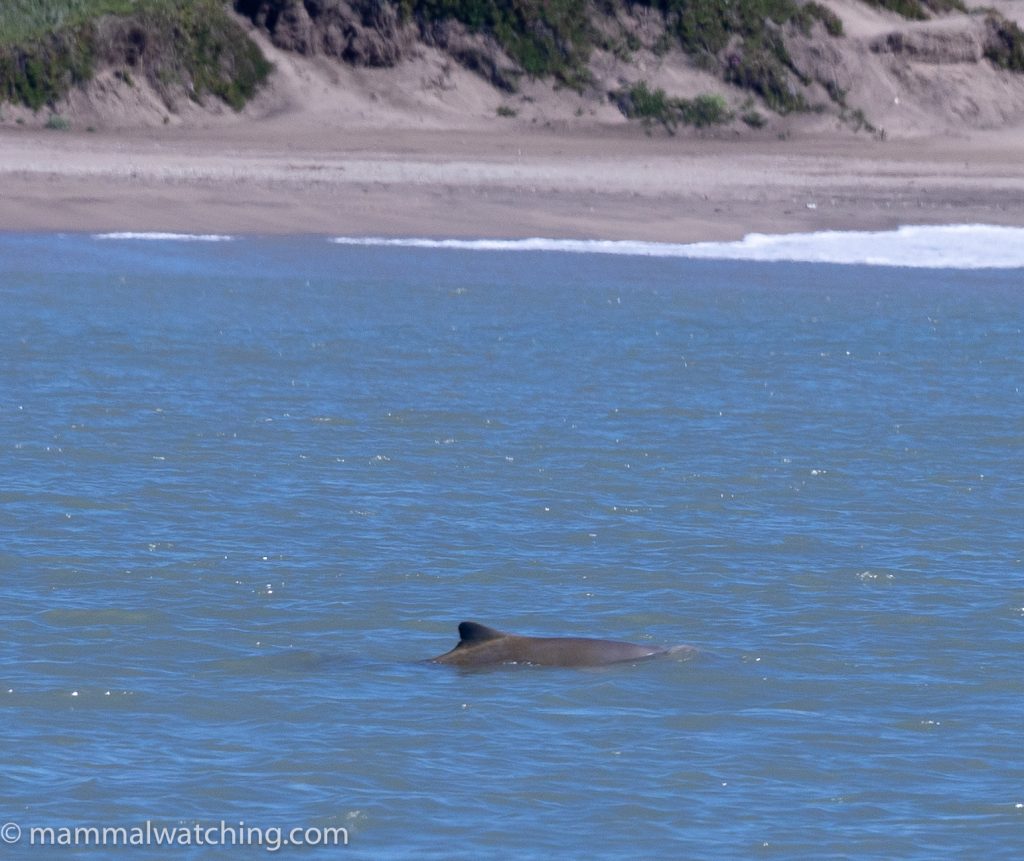
Franciscana (Pontoporia blainvillei)
On the trip back to Mar Chiquita a large grey blob in the water metarphosized into a spy-hopping Southern Elephant Seal.

Southern Elephant Seal (Mirounga leonina)
Delighted with our success we jumped in the car to drive two hours further south to Necohea, our final destination.
Thursday 30 November: Necochea
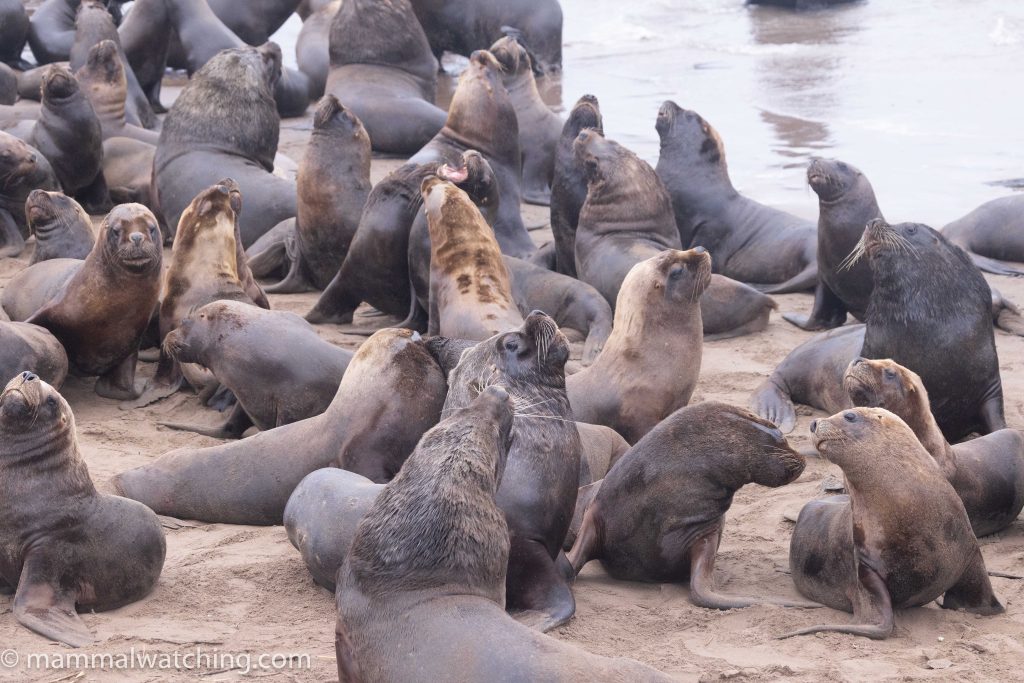
Our last destination and again picked for its Franciscana potential. We had plans to go out the following morning to look for the dolphins with a local fisherman but in the meantime met up with Nahuel Aguirre, a local naturalist, guide and friend of Marcelo’s.
My first target was DuneTuco-tuco. Nahuel had already located an active burrow in front of the local school. Dune Tuco-tucos are restricted to – surprise surprise – the dunes! And so you have to get very close to the beach to be in their habitat. Further inland the Talas Tuco-tuco take over.
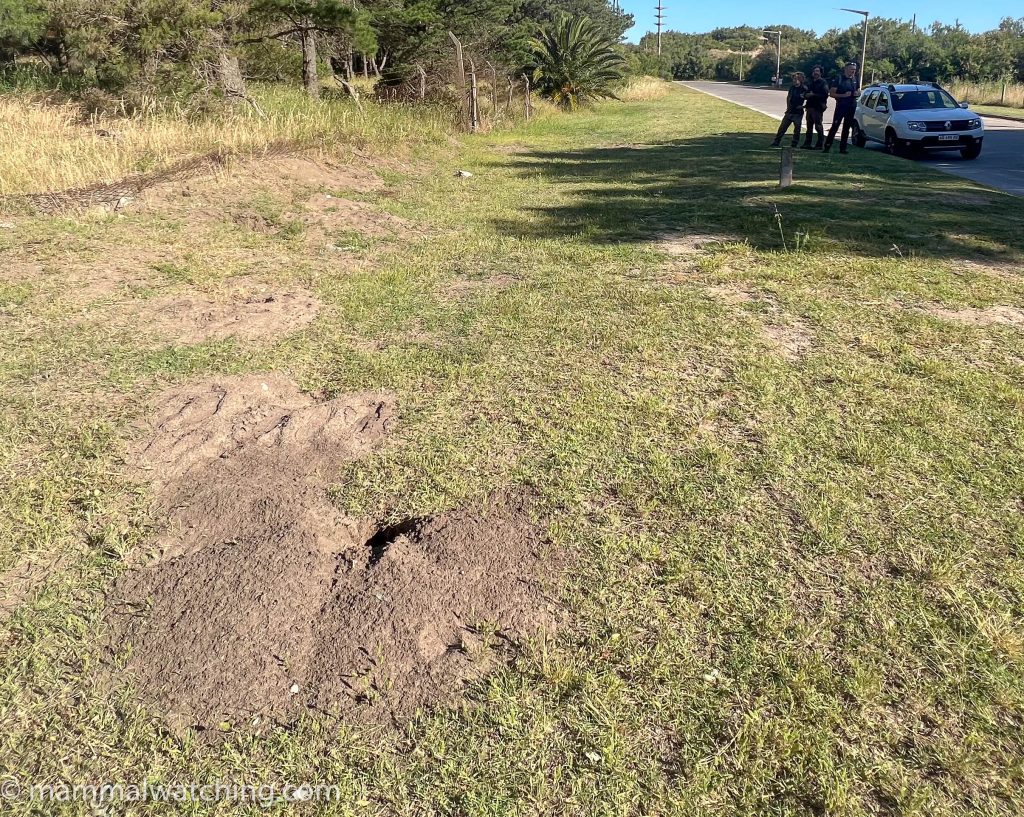
Dune Tuco-tuco Diggings
While I was busy poking holes open and staring into them, a tuco-tuco surfaced briefly in front of everyone else. An hour later it had not returned. I tried to maintain my composure but let’s be, honest, this almost ruined my evening. When Marcelo and I returned early the next morning in the rain the animal was out of its burrow again. I was too slow with my camera so here is a picture Nahuel took the day before we arrived.
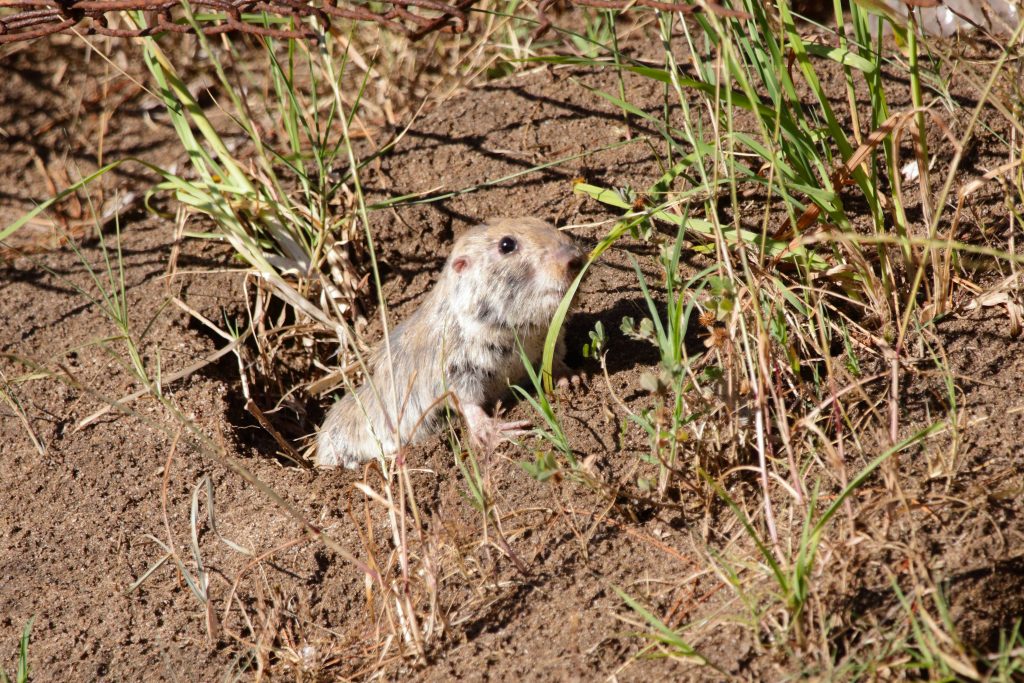
Dune – or Southern – Tuco-tuco (Ctenomys australis). Photo Nahuel Aguirre.
We spent our evening exploring private land an hour away that Nahuel had access too. The habitat looked good for Big Lutrine Opossum and they have been recorded in the area. We didn’t see the opossum but we did see at least 24 Large Hairy Armadillos!
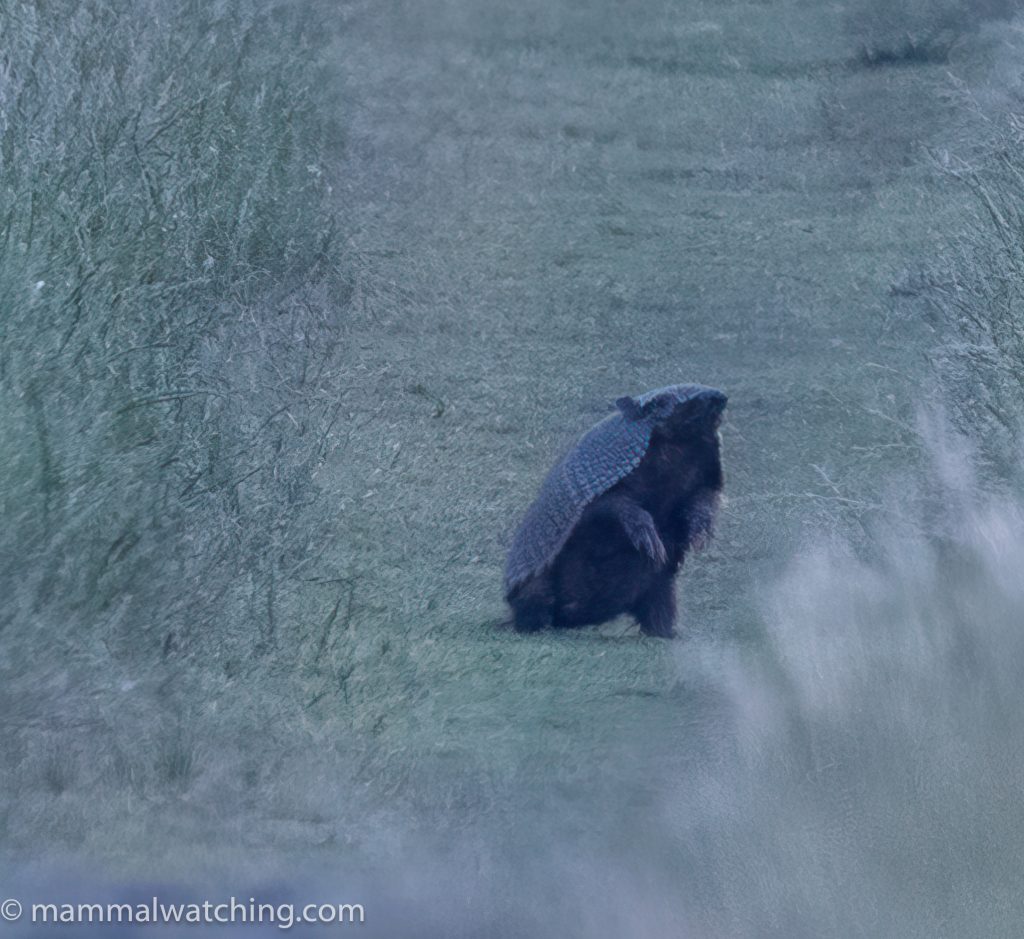
Large Hairy Armadillo (Chaetophractus villosus)
Along with very many Plains Viscachas. Active colonies are easy to locate: just look for a plague of flies when you turn on your spotlight and you are in the right place. They made spotlighting pretty unbearable but away from the burrows they were not a problem here.
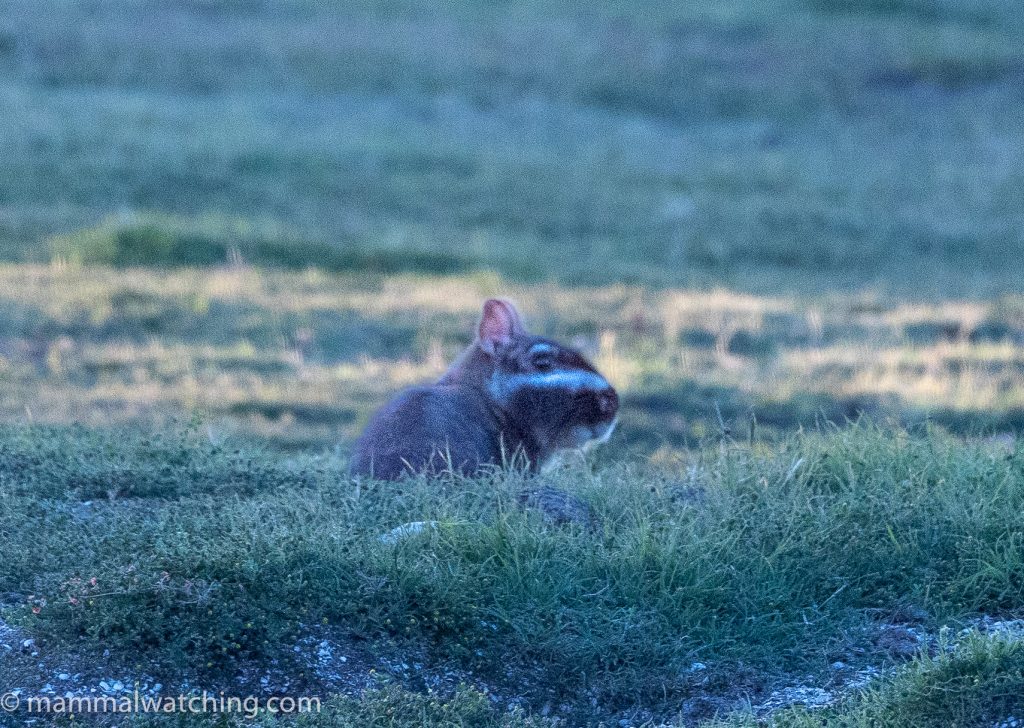
Plains Viscacha (Lagostomus maximus)
Marcelo had some entertaining viscaha stories. Like woodrats, viscachas have a penchant for collecting shiny objects, something Charles Darwin remarked on: “around each group of holes, many bones of cattle, stones, thistle stalks, hard lumps of earth, dry dung are collected into a scattered heap, which frequently amounts to as much as a wheel-barrow could contain. I was credibly informed that a gentleman, when riding on a dark night, dropped his watch; he returned in the morning, & on the line of his road searched the neighbourhood of every Biscatche [Viscacha] hole; & as he expected, he then soon found it.” Even better, Marcelo told us of a record of Plains Viscachas, from El Palmar National Park, carrying a kid’s bicycle back to their burrow!
Other animals that evening included a good look at a Geoffroy’s Cat walking along the trail, White-eared Opossum, Molina’s Hog-nosed Skunk, Pampas Foxes, European Hares, Brazilian Guinea Pigs, Coypu and our only Capybaras of the trip.
The following morning was wet and windy and so, after ticking of the Dune Tuco-tuco, we decided to cancel our Franciscana boat trip. We briefly visited the large South Ameriican Sealion colony in town (here). A smaller colony of South American Fur Seals are here too but at the very end of the breakwater, and so they are not usually visible from the land. We had seen this species in Mar Chiquita, If not I’d have braved the rain and taken the boat out far enough to see them.
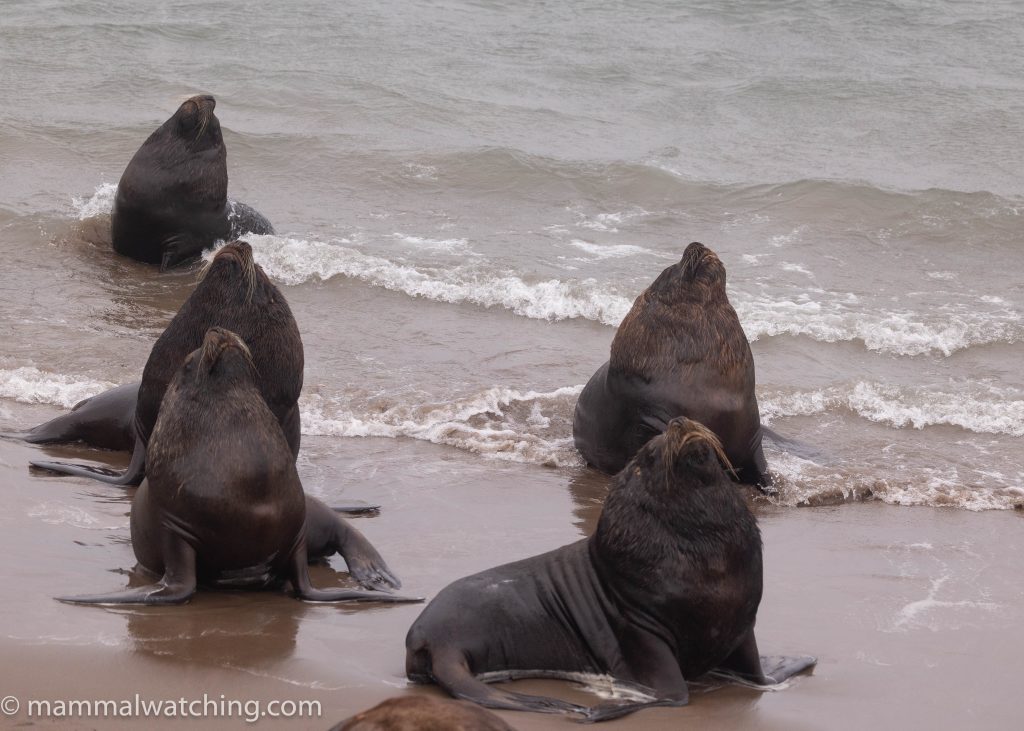
South American Sea Lion (Otaria flavescens)
Friday December 1: The Road Back to Buenos Aries
It took us about 8 hours to drive back to Buenos Aries. We had a great encounter with a Molina’s Hog-nosed Skunk on the way.
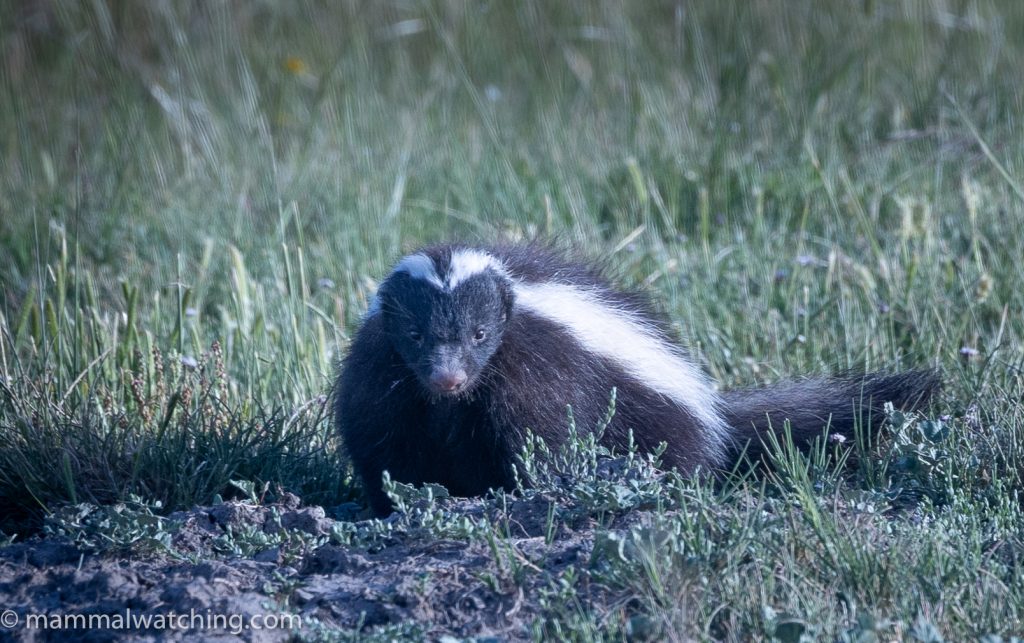
Molina’s Hog-nosed Skunk (Conepatus chinga)
And we also finally had a long look at a pair of Brazilian (Southern) Lesser Long-nosed Armadillos that were waddling along the edge of the highway. Lovely little things.
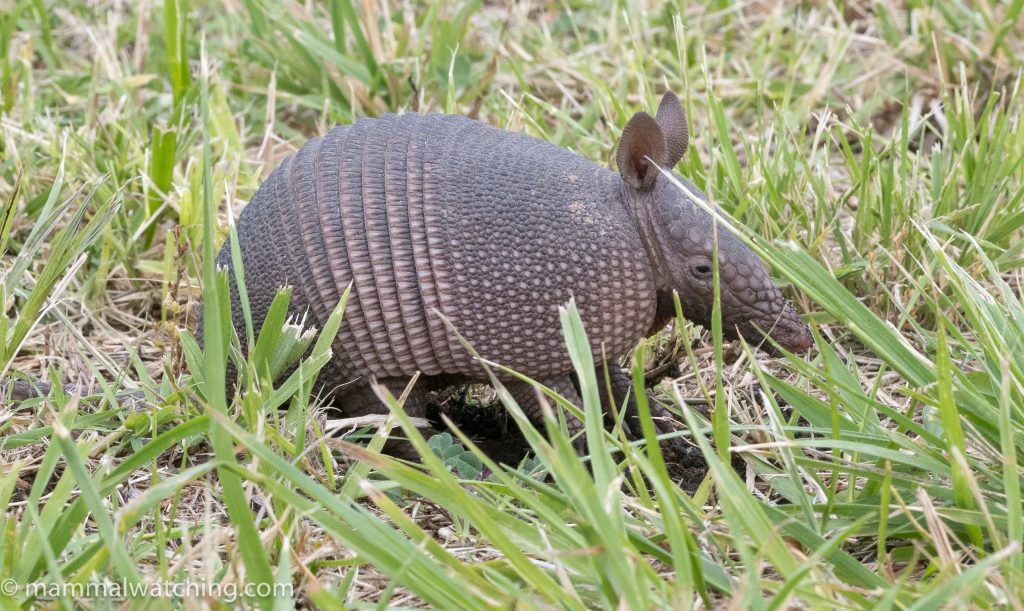
Brazilian Lesser Long-nosed Armadillo (Dasypus septemcinctus)
Marcelo often sees Lesser Grisons along the highway but we were not lucky.
We were back in time for dinner: something I would have hated to have missed in Buenos Aries. The next day Sion and I took the ferry to Montevideo to spend a night there. My trip review: Montevi-don’t! There were no mammals, it was expensive and we should have stayed in BA.
Thank you
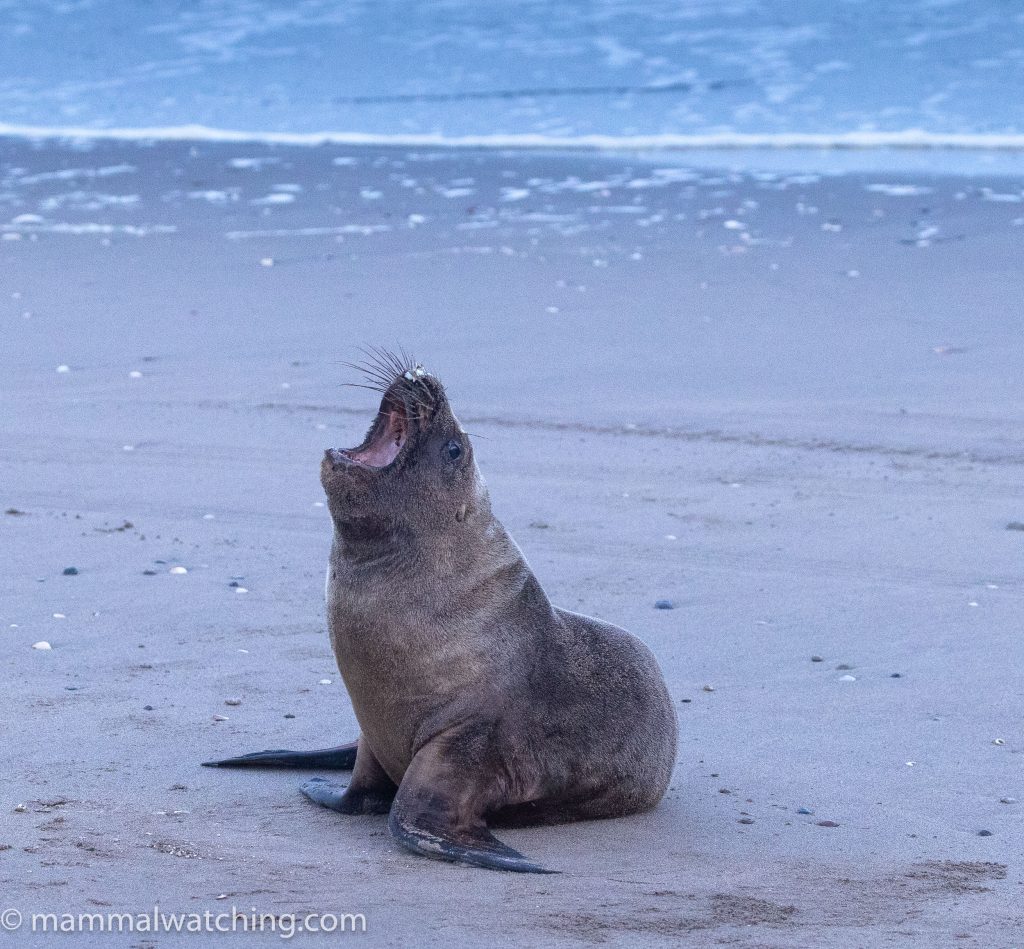
South American Sea Lion (Otaria flavescens)
A big thank you to my travel buddy Sion for being so tolerant and entertaining, and to the many people in hotels and restaurants along the way for taking great care of us (though I pity the fate of any vegetarian brave enough to visit). And a big thanks to the local guides that Marcelo teamed up with, especially Nahuel Aguirre in Necochea. But the biggest thanks has to go to Marcelo. He was hard working, patient, knowledgeable, considerate, always positive, flexible and as keen as we were to find the mammals. He is also great company. And – maybe beyond all that – I love that he has gotten so interested in mammals and the mammalwatching potential in Argentina. He put in a ton of research before the trip because he was so excited about it and it clearly paid off.
His is a wonderful country and with a lot of untapped potential (Marcelo saw a Bush Dog just a couple of weeks before we arrived in the northeast in Misiones Province!). He is the man to talk to if you want help finding some of Argentina’s many mammals. I want to return soon.
Trip List
White-eared Opossum (Didelphis albiventris)
Brazilian Lesser Long-nosed Armadillo (Dasypus septemcinctus)
Screaming Hairy Armadillo (Chaetophractus vellerosus)
Large Hairy Armadillo (C.villosus)
European Hare (Lepus europaeus) – introduced
Brazilian Guinea Pig (Cavia aperea)
Capybara (Hydrochoerus hydrochaeris)
Plains Viscacha (Lagostomus maximus)
Southern Tuco-tuco (Ctenomys australis) – endemic
Talas Tuco-tuco (C.talarum) – endemic
Coypu (Myocastor coypus)
Yellow Pygmy Rice Rat (Oligoryzomys flavescens) (†)
Azara’s Grass Mouse (Akodon azarae)
Brazilian Free-tailed Bat (Tadarida brasiliensis)
Geoffroy’s Cat (Leopardus geoffroyi)
Pampas Fox (Lycalopex gymnocercus)
South American (Southenr) Fur Seal (Arctocephalus australis)
South American Sea Lion (Otaria flavescens)
Southern Elephant Seal (Mirounga leonina)
Molina’s Hog-nosed Skunk (Conepatus chinga)
Chital (Axis axis) – introduced
Pampas Deer (Ozotoceros bezoarticus)
Franciscana (Pontoporia blainvillei)
22 species plus a recently deceased rice rat. 6 lifers (bold).
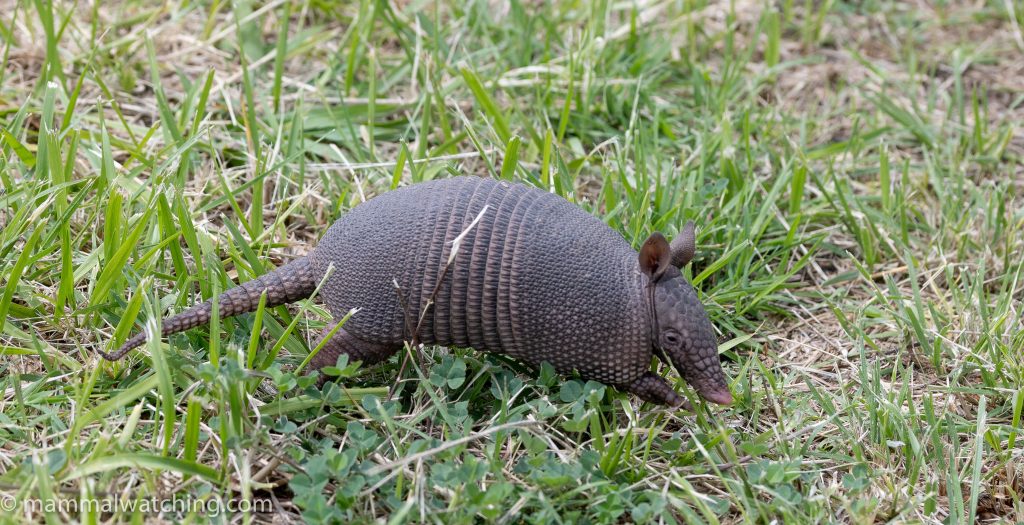
Brazilian Lesser Long-nosed Armadillo (Dasypus septemcinctus)
Post author
2 Comments
Leave a Reply
You must be logged in to post a comment.


JanEbr
What an eye-opening report for me. I have been to BA so many times (we have an observatory in Argentina where we take care of some instruments), but it never even crossed my mind to think about the province as a destination – it’s just cattle farm next to another cattle farm after all. Yes, maybe some people have already been there and I could have looked it up, but a new front-page report is always easier to notice 🙂 I think I will have to take a couple of days off in BA at some point. Well, that is if Argentina does not collapse – the situation is disturbing, maybe more than it is apparent from just reading the news.